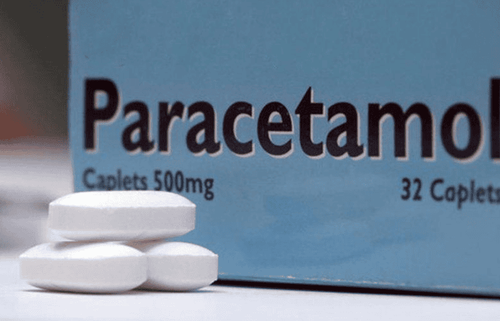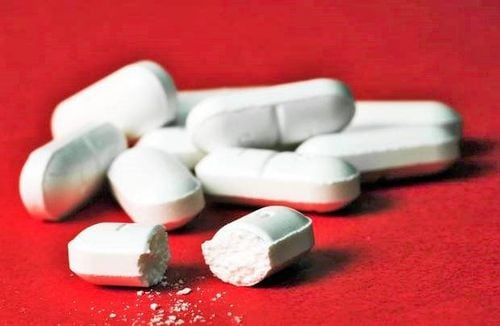This is an automatically translated article.
Bamyrol contains the main active ingredient, Paracetamol, a pain reliever and fever reducer used very commonly today. The mechanism of action of the drug is to affect the hypothalamus causing exothermic effects due to vasodilation and increased peripheral blood flow.1. What is Bamyrol 150?
Bamyrol is a form of oral nuggets with the main active ingredient being Paracetamol with a content of 150mg. Paracetamol is an effective pain reliever and fever reducer widely used today. However, paracetamol has no anti-inflammatory activity. The mechanism of action of the drug is to affect the hypothalamus causing exothermic effects due to vasodilation and increased peripheral blood flow. Paracetamol at therapeutic doses has almost little effect on the cardiovascular and respiratory systems, does not cause irritation or gastric ulcer. In addition, Paracetamol has no effect on systemic cyclooxygenase but only on central nervous system cyclooxygenase.2. Uses of the drug Bamyrol
Bamyrol is indicated for the treatment of mild to moderate pain and fever, especially in patients who are contraindicated or unable to take salicylates. The drug has a good effect on mild pain of non-visceral origin.3. Contraindications of Bamyrol
Bamyrol is contraindicated for use in the following cases:
Patients with hypersensitivity to Paracetamol. Cases of deficiency of the enzyme Glucose - 6 - phosphate dehydrogenase Patients with impaired liver function. The patient is often anemic or has heart, lung or kidney disease.
4. Dosage of the drug Bamyrol
Because it is prepared in the form of granules mixed with oral suspension, Bamyrol is suitable for children. Dosage of Bamyrol will vary depending on the condition and weight of each baby. The following is a reference dose:
Children: The recommended dose is 10-15mg/kg/time, taken every 4-6 hours as needed (maximum 5 times/day). Note that pain medication should not be used for more than 5 days in children, unless directed by a doctor because severe, persistent pain can be a sign of a medical condition. Do not self-medicate for high fever (above 39.5°C), fever lasting more than 3 days, or recurrent fever, unless directed by a physician. To limit the risk of overdose, children should not be given more than 5 doses to relieve pain or reduce fever within 24 hours.
5. What are the side effects of Bamyrol?
Skin rashes and allergic reactions have occasionally occurred in patients receiving Bamyrol. Usually erythema or urticaria, but sometimes more severe, may be accompanied by drug fever and mucosal lesions. In isolated cases, Paracetamol can cause neutropenia, thrombocytopenia and pancytopenia.
6. Bamyrol overdose and treatment
6.1 Symptoms In overdose of Bamyrol, a metabolite of paracetamol, N-acetyl-benzoquinonimin, can cause severe hepatotoxicity. Paracetamol toxicity can be caused by repeated large doses or by long-term use of the drug. The most serious acute toxic effect is dose-dependent liver necrosis and even death. Symptoms of nausea, vomiting, and abdominal pain usually occur within 2-3 hours after taking a toxic dose of Bamyrol. In addition, methemoglobinemia leading to cyanosis of the skin, mucous membranes and nails is a hallmark of acute toxicity. Children have a higher tendency to have methemoglobin than adults after taking Paracetamol. In severe poisoning, patients may initially experience central nervous system excitability, agitation, and delirium. This is followed by CNS depression, hypothermia, fatigue, shallow breathing, tachycardia, weakness, irregularity, and circulatory failure. Vascular collapse due to hypoxemia occurs only with very large doses.
6.2 Management Early diagnosis is important in the treatment of Bamyrol overdose. In severe poisoning, active supportive treatment is required. Gastric lavage should be performed, preferably within 4 hours of ingestion. The primary antidote is to administer the drug N-acetylcysteine (oral or intravenous) immediately if it has not been 36 hours since the Bamyrol overdose. Treatment with N-acetylcysteine is more effective when administered less than 10 hours after paracetamol ingestion. The loading dose of N-acetylcysteine was 140 mg/kg, followed by another 17 doses of 70 mg/kg 4 hours apart. End treatment if plasma Paracetamol concentration test shows low risk of hepatotoxicity. If N-acetylcysteine is not available, methionine can be substituted. In addition, activated charcoal can be used because it has the ability to reduce the absorption of Paracetamol in the gastrointestinal tract.
7. Notes when using Bamyrol
Patients should be warned about symptoms of serious skin reactions such as Stevens-Johnson syndrome (SJS), toxic epidermal necrolysis (TEN), Lyell's syndrome, and generalized pustular rash. acute before taking Bamyrol Use caution when administering Bamyrol in patients with pre-existing anemia, patients with impaired liver/renal function. Bamyrol should be used with caution in patients with hepatic impairment or active liver disease because the drug may cause hepatotoxicity. Thrombocytopenia, leukopenia and pancytopenia have been reported in patients receiving the drug, especially with prolonged use in large doses. Agranulocytosis has been reported rarely in patients receiving Bamyrol. Pregnancy: Due to physiological changes during pregnancy, some of the pharmacokinetic properties of the drug may be altered. Bamyrol is considered suitable for the treatment of pain and fever during pregnancy. The drug is recommended to be used at the lowest effective dose for the shortest time to effectively treat the mother and protect the health of the fetus. Lactating women: The drug can be excreted in breast milk. Paracetamol is one of the preferred pain relievers and is compatible with breastfeeding when used at commonly recommended doses Drug interactions: Here are some drug interactions to watch out for while taking Bamyrol.
Long-term use of high doses of Bamyrol may slightly increase the anticoagulant effect of coumarins and indandion derivatives. There is a risk of severe hypothermia with Bamyrol in patients receiving concomitant phenothiazines and other antipyretic therapy. Heavy and long-term alcohol consumption may increase the risk of hepatotoxicity of Bamyrol Anticonvulsants (including phenytoin, barbiturates, carbamazepine) induce liver enzymes, which may increase the hepatotoxicity of Bamyrol. due to increased metabolism of drugs to toxic to the liver. Concomitant administration of Bamyrol with isoniazid may lead to increased hepatotoxicity. This risk was significantly increased in patients taking larger than recommended doses of Bamyrol while taking isoniazid. The information about Bamyrol above is for reference only and cannot completely replace the guidance of a physician. Therefore, patients should consult a doctor or pharmacist before using the drug.
Please dial HOTLINE for more information or register for an appointment HERE. Download MyVinmec app to make appointments faster and to manage your bookings easily.













